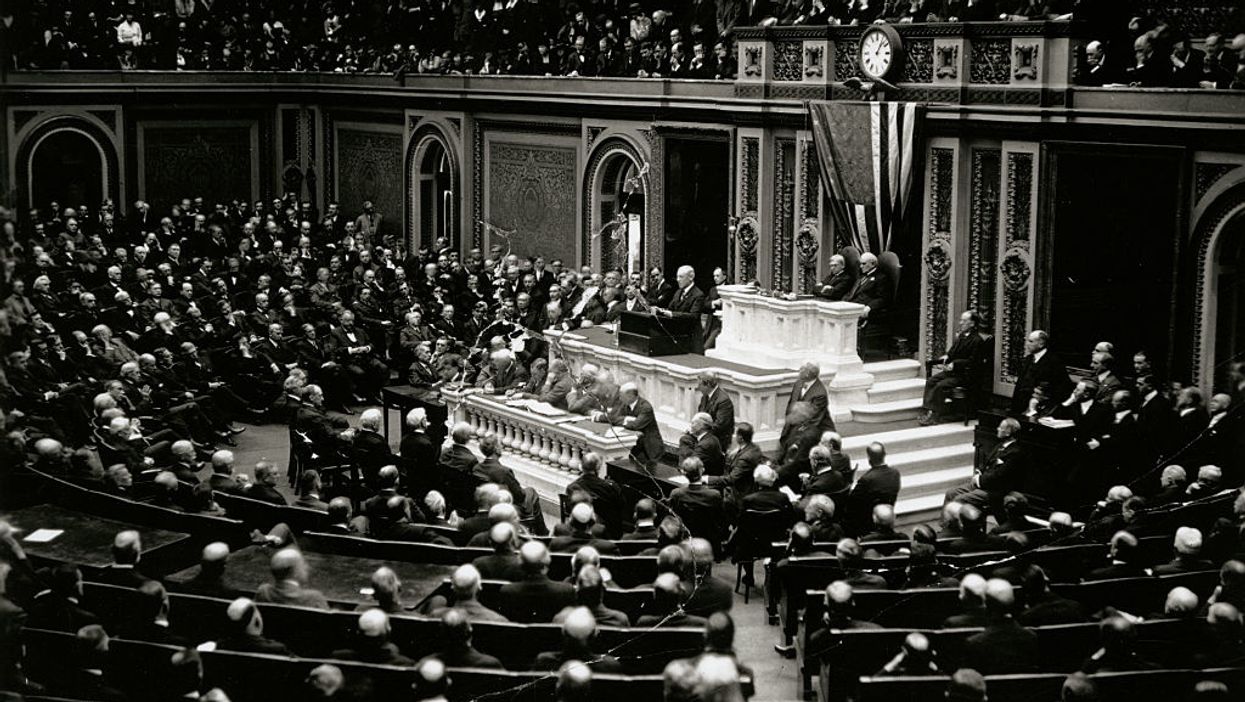
Photo by Harris & Ewing/Library of Congress/Corbis/VCG via Getty Images

Nothing. Absolutely
nothing.
In fact, not only did President Woodrow Wilson fail to speak about his own illness, there are no known records of major speeches ever delivered by the 28th president about the Spanish flu, which killed the equivalent of 2.2 million people in today's population with the median age of death being a tender 28.
The Spanish flu was a greater calamity than COVID-19 in every way and President Wilson got a lot sicker from it than Trump has from this virus. In April 1919, after the worst of the Spanish flu has passed, Wilson contracted the virus in Paris while meeting at the Big Four peace talks about the aftermath of World War I. Rear Adm. Cary T. Grayson described the president as having been "suddenly taken violently sick with the influenza at a time when the whole of civilization seemed to be in the balance."
Wilson never discussed his illness publicly and the country was unaware of the extent of his illness at the time. This silence reflected a broader mentality at the time, an understanding that the ability of human beings to change the arc of a respiratory virus through public policy is extremely limited.
With this in mind, I was curious to research what Wilson had said about the Spanish flu during the 1918 State of the Union address. That year, the address was delivered on Dec. 2 – just weeks after the peak months of the virus when hundreds of thousands of very young Americans perished. What words of healing and inspiration did he offer? What sort of public policy promises, proclamations, mandates, and restrictions did he announce?
Zero. Zilch. Nada.
There was absolutely no mention or fleeting reference to the Spanish flu in that or any other State of the Union address – or any other major speech for that matter.
It's truly hard to overstate the enormity of this observation, especially looking through today's COVID-obsessed political lens. The State of the Union address was a big deal for Wilson. Ever the show-boater, Wilson
was the first president since John Adams to restore the annual address to the prominence of a live in-person speech before Congress. Thomas Jefferson, who felt that the address reeked of European monarchism, began a tradition of mailing in a written report to Congress.
The fact that Wilson failed to mention a word about the virus, even amid the fallout from World War I, speaks volumes. This virus today is not nearly as devastating in terms of the true death toll and years of life lost as the Spanish flu. But still, imagine Trump delivering the address in a few months and failing to mention a word about it?
The reality is that society understood in those days that a respiratory virus, unlike a war, is a God-made plague and that there is little that can be done to mitigate its spread. There is no known method of arresting the spread of a virus and making it disappear. The best we can do is focus on treatment, which is thankfully getting better. Unfortunately, in 1918, they lacked antibiotics and so many other staples of medicine we rely on today.
Rather than educating the public on the best use of vitamins, zinc, hydroxychloroquine and other available remedies, the public health "experts" sold us a bill of goods – that somehow, we could avoid getting the virus by hiding and running forever. We now see that it's foolish to think you could run or hide from or arrest the spread of such a virus.
In past generations, they understood that trying to stop the spread of flu-like viruses is a fool's errand. As Dr. Andrew Bostom, an academic medical researcher and associate professor of family medicine at Brown University, noted on Twitter Sunday, barely anyone remembers the Hong Kong flu of 1968 or that President Johnson was hospitalized with it.
As Dr. Bostom notes, "The adjusted death toll for the '68-'69 Hong Kong flu would be ~265K." A similar dynamic played out in 1957 during the Asian flu, which killed even more people, especially when considering that there are so many more seniors in America today. Try asking your parents if they remember living through those epidemics. Everyone remembers Woodstock in 1968, but very few people remember the Hong Kong flu or Asian flu.
That is because public officials realized that disrupting people's lives would only harm society, not stop the spread of a respiratory virus. As D.A. Henderson, the former dean of Johns Hopkins School of Public Health, who is widely credited with helping to eradicate smallpox, wrote in a 2009 analysis of the Asian flu, "This was in recognition that they saw no practical means for limiting the spread of infection."
Henderson warned in a paper a few years earlier, "Experience has shown that communities faced with epidemics or other adverse events respond best and with the least anxiety when the normal social functioning of the community is least disrupted."
Not only have today's leaders repudiated the concept of normalcy, they have turned a national panic and psychosis into a "new normal." And we are continuing to pay for the consequences of '15 years to flatten the curve.'
Daniel Horowitz
Blaze Podcast Host